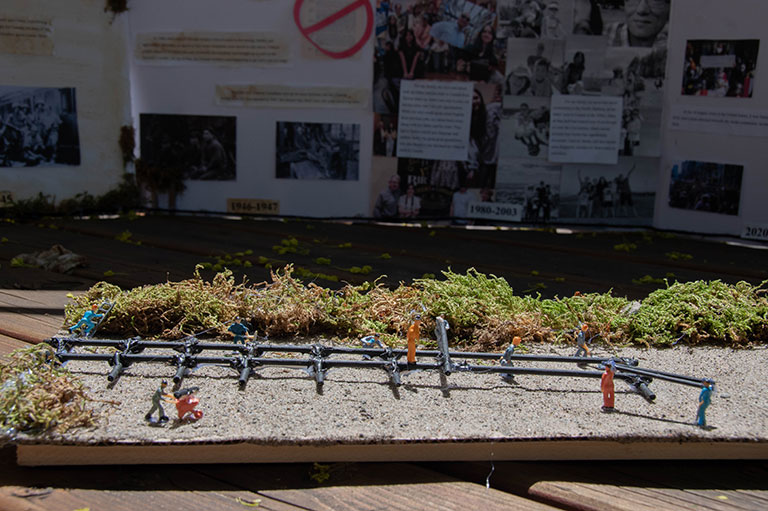Evelyn C. and Cynthia R.

The History of Chinese Immigration to Canada
Evelyn C. and Cynthia R.
Durham Regional Heritage Fair
Whitby, ON
The most notable events we covered were ones that, if they never occurred, Chinese Canadians would live a very different life than the one they live today, beginning with the construction of the Pacific Railway. Over 17,000 Chinese workers came to Canada. 600 to 4,000 of these men died due to problematic living conditions, commonly accidents that would occur since Chinese workers were given dangerous jobs. Despite this torment, they were paid under half of what White workers were paid.
The Chinese head tax is also noteworthy. It originally cost $50, trying to keep Chinese immigrants out of Canada. The tax was expeditiously raised to $100 then later $500. Canada grossed $23 million from 82,000 Chinese immigrants, one of whom was my great-great-grandfather, who paid a sum of $100 in 1903.
The next event began when the Asiatic Exclusion League was formed because British Columbians were scared Chinese people would take their jobs. They stormed Chinatown and Little Tokyo, causing $70,000 in damages. Still, only one person was ever convicted of taking part in these riots.
WWII holds significance to this topic because it created unity. Chinese people enlisted in the military to create peace with Canadians, which caused a change in the treatment towards Chinese Canadians. Paul Chan is one of four Chinese Canadian brothers who fought in WWII. He was stationed around the world and had to learn various skills for survival.
To answer our inquiry question, we’d say the experiences Chinese immigrants faced shaped immigration to Canada today because their story is a lesson learned that today can be seen as a reminder that we cannot let the future generations of Canadian immigrants be treated the same way. From unfair labour conditions to discriminatory acts, this story reminds us all to do better.
What sources and evidence did you consult for your project? What different perspectives did they provide on your topic?
When making our project, we used sources such as the Library and Archives Canada and The Canadian Encyclopedia to make sure that the information and content we used was credible and was mostly written and/or created by Canadians. Canadian museum websites about Chinese-Canadian history were also used, considering they have historic memorabilia to study.
We also decided to study articles written by Evelyn’s aunt Debbie as well as personally ask her any questions we may have regarding Chinese immigration and family history. We decided to refer to articles written by her because it gave us a more direct perspective about Chinese-Canadians, as Debbie had more insights when it came to this topic, and it really helped us, especially when we were talking about the Chinese head tax. She has documents from when Evelyn’s great-great-grandfather came to Canada and had to pay the head tax, which was something we discovered only while researching this project! Debbie was able to supply us with a photograph of a form Evelyn's great-great-grandfather filled out called a C.I.9, or Chinese Immigration Form #9, which was a Canadian re-entry certificate specifically meant for Chinese people. It was extremely eye-opening seeing someone with such close relations to us being affected by issues we researched and gave us a larger perspective of just how impactful this project truly is.
During our research on this topic, we tried to use as many primary sources as possible since we really wanted to learn more about our chosen topic. From newspaper articles to family documents and even racist cartoons, we wanted to cover as many types of primary sources as possible. We also used this time to dive into the perspectives of influential Chinese-Canadians such as Paul Chan, a Chinese-Canadian war veteran, to let their stories be heard.
Since we covered every aspect of Chinese immigration to Canada to build a complete timeline, we tried to provide an accurate representation of how they likely felt at the time, including using visuals on our board. We would theme each section to depict the era and the topic being discussed. Fake glass when speaking on the riots in Chinatown, Chinese newspapers used as the background of our section on the Great Depression, sand and moss being added to depictions of the construction of the Pacific Railway, and WWII created an interesting 3D aspect that truly brought our board to life. We also built a diorama of the construction of the Pacific Railway to let our audiences step into that historic moment which made all the difference.
 A model depicting the construction of the Canadian Pacific Railway.
A model depicting the construction of the Canadian Pacific Railway.
What is the historical significance of your topic?
The topic of Chinese immigration to Canada is significant historically because Chinese immigrants have made significant contributions to Canada, and without their arrival as immigrants, features and moments that make Canada iconic may never have existed. Chinese people have helped build Canada and have helped fight for Canada all while being discriminated against. Chinese immigrants helped build the Pacific Railway, one of Canada's largest railways. When the construction of the Pacific Railway finished, a famous photo known as The Last Spike was taken while the Chinese workers were left out of the photo despite the fact that about three-quarters of the workers were of Chinese descent.
In WWII, many Chinese-Canadians fought hard for their home, even giving their lives in some cases, all while not even having the right to vote. The work Chinese people did also helped raise Canada's economy. These are only a few examples of how Chinese people contributed to Canada, and there are likely many more to be uncovered. Chinese people are one of the largest ethnic groups to come to Canada and they have helped shape this country with their bare hands. If that's not significant, I don't know what is.
Chinese immigration to Canada had significant short- and long-term effects on Canada. They faced extensive discrimination and segregation laws, such as the Chinese head tax and the Chinese Immigration Act of 1923, an act that banned Chinese immigrants from coming to Canada. The short-term effects of these acts were that they stopped Chinese immigrants from entering Canada, the Canadian government's goal exactly. While the long-term effect was that families were separated and many people struggled financially due to the tax, the even longer-term effect was that it created a distrust between the Chinese community and the Canadian government. These acts created long-term emotional trauma that would take years to recover from, and today we see that this path of racism hasn't ended.
The long-term impact the entire story of Chinese immigrants coming to Canada had was that through the hardships and contributions of Chinese immigrants, it shaped the Canada we live in now by playing a key role in advancing civil rights and shaping Canada’s multicultural identity. Nowadays Chinese Canadians are one of the country’s largest and most vibrant ethnic groups.
Why did you choose this topic?
We chose this topic because we have a personal and strong connection with this crucial story in Canada’s history. For me (Evelyn), my YéYe and NâiNai (grandfather and grandmother) took my father and his sister to Canada when he was only six and his sister was three. At the airport my father’s backpack was so heavy he fell back because he described it as his entire life being on his back. In Canada, none of them knew English other than my YéYe, so they had to learn a whole new language and culture away from any friends or family.
My great-great-grandfather also unfortunately was forced to pay the head tax when he came to Canada (as mentioned earlier), which is something I only learned when working on this project from my aunt Debbie Jiang, who also has a deep appreciation for Chinese immigration. In fact, she actually was a co-editor and wrote most of a kayak magazine called “Beyond the Gold Mountain: Canadians of Chinese Descent,” which can be found on the Canada's History website. We were fortunate enough to get questions answered from her, considering that she’s quite knowledgeable on this topic.
Truly for us, as children of Chinese immigrants, we are extremely thankful that a road has been paved to acceptance since we want to demonstrate with our project that Chinese people aren’t just the nerds, or the people who speak poor English, or the children with strict parents, but rather the people who were brave enough to uproot their lives to a whole new country with a different culture and language to provide better opportunities for ourselves and children. So, this topic was chosen as a way to pay homage to our community and cultural heritage.
For me (Cynthia), the reason I decided to choose and work on this topic with Evelyn is because while my father came to Canada in the 2000s, where he didn't have to deal with any discriminatory acts, he still had plenty of hardships throughout his first years here. Many of his colleagues believed at first that just because his English wasn’t as good as theirs was, it made him shallow, and he underwent countless racist behaviours in his first few years living here.
Now, even in the 21st century, where discrimination and racism isn't as common as it used to be, we still sometimes face racism, whether it’s at school or in a workspace. Especially when Covid started, a lot of my classmates would ridicule me for being Chinese and “starting the virus." I also would get hate comments outside of school, such as the time when I was only 6 years old and was downtown with my father when an intoxicated man yelled at us to "go back to where we came from." These experiences are also not only isolated to my family. Many Chinese-Canadians, to this day, face hate crimes constantly.
Because of this project, we have been able to connect with others from our community who have felt touched by our work. We've even had people cry because they were so overwhelmed with the comfort they felt from our presentation, which was such a beautiful moment to be a part of. This is why we wear qipaos (traditional Chinese dresses) when presenting, so other Chinese children like us can see their clothing being worn in public and be reminded that their culture is nothing to be ashamed of.
So, the reason we chose this topic is because we feel the Chinese community isn’t getting the spotlight they deserve, and we’re here because we would like to give a voice to those who weren't given one and represent them to show everyone what we have contributed to Canada even if we were treated as an afterthought. This is more than a project to us. This topic was chosen as a way to pay back our community for all that they did to get us here because without them we probably wouldn't be the girls we are today.

